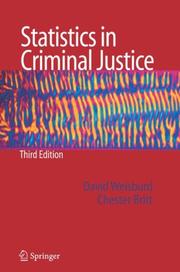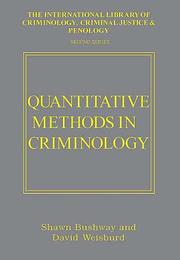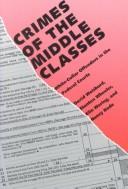| Listing 1 - 10 of 67 | << page >> |
Sort by
|
Book
ISBN: 1316484874 1139342088 1316481867 110702952X 1107609496 Year: 2016 Publisher: Cambridge : Cambridge University Press,
Abstract | Keywords | Export | Availability | Bookmark
 Loading...
Loading...Choose an application
- Reference Manager
- EndNote
- RefWorks (Direct export to RefWorks)
Over the last two decades, there has been increased interest in the distribution of crime and other antisocial behavior at lower levels of geography. The focus on micro geography and its contribution to the understanding and prevention of crime has been called the 'criminology of place'. It pushes scholars to examine small geographic areas within cities, often as small as addresses or street segments, for their contribution to crime. Here, the authors describe what is known about crime and place, providing the most up-to-date and comprehensive review available. Place Matters shows that the study of criminology of place should be a central focus of criminology in the twenty-first century. It creates a tremendous opportunity for advancing our understanding of crime, and for addressing it. The book brings together eighteen top scholars in criminology and place to provide comprehensive research expanding across different themes.
Criminology --- Criminology, Penology & Juvenile Delinquency --- Social Welfare & Social Work --- Social Sciences --- Crime --- Social sciences --- Criminals --- Study and teaching --- Criminology.
Book
ISBN: 3030479676 3030479668 Year: 2020 Publisher: Cham, Switzerland : Springer,
Abstract | Keywords | Export | Availability | Bookmark
 Loading...
Loading...Choose an application
- Reference Manager
- EndNote
- RefWorks (Direct export to RefWorks)
This introductory textbook takes a building-block approach that emphasizes the application and interpretation of statistics in research in crime and justice. This text is meant for both students and professionals who want to gain a basic understanding of common statistical methods used in criminology and criminal justice before advancing to more complex statistical analyses in future volumes. This book emphasizes comprehension and interpretation. As the statistical methods discussed become more complex and demanding to compute, it integrates statistical software. It provides readers with an accessible understanding of popular statistical programs used to examine real-life crime and justice problems (including SPSS, Stata, and R). In addition, the book includes supplemental resources such as a glossary of key terms, practice questions, and sample data. Basic Statistics in Criminology and Criminal Justice aims to give students and researchers a core understanding of statistical concepts and methods that will leave them with the confidence and tools to tackle the statistical problems in their own research work.
Criminal statistics. --- Crime --- Crime statistics --- Criminal courts --- Criminal justice, Administration of --- Criminal law --- Criminal procedure --- Criminals --- Criminology --- Judicial statistics --- Statistical methods --- Statistics --- Criminology. --- Social sciences --- Statistics in Social Sciences, Humanities, Law, Education, Behavorial Sciences, Public Policy. --- Statistical methods. --- Study and teaching
Book
ISBN: 9781107029521 9781107609495 Year: 2016 Publisher: New York : Cambridge University Press,
Abstract | Keywords | Export | Availability | Bookmark
 Loading...
Loading...Choose an application
- Reference Manager
- EndNote
- RefWorks (Direct export to RefWorks)
Book
Year: 1997 Publisher: Washington (D.C.) U.S. Department of Justice
Abstract | Keywords | Export | Availability | Bookmark
 Loading...
Loading...Choose an application
- Reference Manager
- EndNote
- RefWorks (Direct export to RefWorks)
Multi
ISBN: 9781139342087 9781107029521 9781107609495 Year: 2016 Publisher: Cambridge Cambridge University Press
Abstract | Keywords | Export | Availability | Bookmark
 Loading...
Loading...Choose an application
- Reference Manager
- EndNote
- RefWorks (Direct export to RefWorks)

ISBN: 0387341137 0387341129 1441941622 Year: 2007 Publisher: New York, NY : Springer US : Imprint: Springer,
Abstract | Keywords | Export | Availability | Bookmark
 Loading...
Loading...Choose an application
- Reference Manager
- EndNote
- RefWorks (Direct export to RefWorks)
Statistics in Criminal Justice takes an approach that emphasizes the uses of statistics in research in crime and justice. This text is meant for students and professionals who want to gain a basic understanding of statistics in this field. The text takes a building-block approach, meaning that each chapter helps to prepare the student for the chapters that follow. It also means that the level of sophistication of the text increases as the text progresses. Throughout the text there is an emphasis on comprehension and interpretation, rather than computation. However, it takes a serious approach to statistics, which is relevant to the real world of research in crime and justice. This approach is meant to provide the reader with an accessible but sophisticated understanding of statistics that can be used to examine real-life criminal justice problems. The goal of the text is to give the student a basic understanding of statistics and statistical concepts that will leave the student with the confidence and the tools for tackling more complex problems on their own. Statistics in Criminal Justice is meant not only as an introduction for students but as a reference for researchers. New to the 3rd Edition A number of changes have been made to the 3rd edition, including the following: Additional exercises at the end of each chapter. Expanded computer exercises that can be performed in the Student Version of SPSS. Extended discussion of multivariate regression models, including interaction and non-linear effects. A new chapter on multinomial and ordinal logistic regression models, examined in a way that highlights comprehension and interpretation. With the additional material on multivariate regression models, the text is appropriate for both undergraduate and beginning graduate statistics courses in criminal justice.
Criminal statistics. --- Criminal statistics --- Mathematical models. --- Crime --- Crime statistics --- Criminal courts --- Criminal justice, Administration of --- Criminal law --- Criminal procedure --- Criminals --- Criminology --- Judicial statistics --- Statistical methods --- Statistics --- Criminology. --- Criminology and Criminal Justice, general. --- Social sciences --- Study and teaching

ISBN: 0754624463 9780754624462 Year: 2005 Publisher: Aldershot Ashgate
Abstract | Keywords | Export | Availability | Bookmark
 Loading...
Loading...Choose an application
- Reference Manager
- EndNote
- RefWorks (Direct export to RefWorks)
Criminal statistics --- Criminology --- Mathematical models --- Criminal statistics. --- Mathematical models. --- Research --- Methodology. --- Crime --- Social sciences --- Criminals --- Crime statistics --- Criminal courts --- Criminal justice, Administration of --- Criminal law --- Criminal procedure --- Judicial statistics --- Research&delete& --- Methodology --- Study and teaching --- Statistical methods --- Statistics --- Criminology - Mathematical models
Book
ISBN: 1461456894 1461456908 1461456916 Year: 2014 Publisher: New York, NY : Springer New York : Imprint: Springer,
Abstract | Keywords | Export | Availability | Bookmark
 Loading...
Loading...Choose an application
- Reference Manager
- EndNote
- RefWorks (Direct export to RefWorks)
The Encyclopedia of Criminology and Criminal Justice is an international, comprehensive reference tool for the field of Criminology and Criminal Justice that is both cutting edge as well as of very high scientific quality and prestige. This 10-volume work provides a complete and systematic coverage of the field that is unprecedented. The Encyclopedia "defines the field" through its choice of organization and entries. It identifies and brings emerging ideas and trends to the forefront. The Encyclopedia covers Criminology and Criminal Justice in ten broad areas, with leading researchers writing substantive contributions within their area of expertise: Corrections and Criminal Justice Supervision in the Community Courts, Sentencing and the Judicial System Crimes, Criminals and Victims Crime Places and Situations Explanations for Criminal Behavior Forensic Science Data, Methods, and Statistics Police and Law Enforcement Psychology of Law Social Interventions and Prevention This work features approximately 600 entries, organized in alphabetical order. The work is comprised under the direction of two Editors-in-Chief in consultation with 12 Associate Editors and more than 180 Area Editors. It is an essential and dynamic reference for researchers in the fields of Criminology and Criminal Justice, as well as useful a research tool for those in related fields of the social and behavioral sciences.
Social sciences. --- Criminology. --- Social Sciences. --- Criminology & Criminal Justice. --- Criminology --- Criminal justice, Administration of --- Social Welfare & Social Work --- Social Sciences --- Criminology, Penology & Juvenile Delinquency --- Administration of criminal justice --- Crime --- Behavioral sciences --- Human sciences --- Sciences, Social --- Social science --- Social studies --- Law and legislation --- Study and teaching --- Criminology and Criminal Justice. --- Criminology and Criminal Justice, general. --- Social sciences --- Criminals
Book
ISBN: 146149169X 1461491703 Year: 2014 Publisher: New York, NY : Springer US : Imprint: Springer,
Abstract | Keywords | Export | Availability | Bookmark
 Loading...
Loading...Choose an application
- Reference Manager
- EndNote
- RefWorks (Direct export to RefWorks)
Statistics in Criminal Justice takes an approach that emphasizes the application and interpretation of statistics in research in crime and justice. This text is meant for both students and researchers who want to gain a basic understanding of common statistical methods used in this field. In general, the text relies on a building-block approach, meaning that each chapter helps to prepare the student for the chapters that follow. It also means that the level of sophistication of the text increases as the text progresses. Throughout the text there is an emphasis on comprehension and interpretation, rather than computation. However, as the statistical methods discussed become more complex and demanding to compute, there is increasing use and integration of statistical software. This approach is meant to provide the reader with an accessible, yet sophisticated understanding of statistics that can be used to examine real-life criminal justice problems with popular statistical software programs. The primary goal of the text is to give students and researchers a basic understanding of statistical concepts and methods that will leave them with the confidence and the tools for tackling more complex problems on their own. New to the 4th Edition: • New chapter on experimental design and the analysis of experimental data. • New chapter on multi-level models • More advanced discussions of statistical power, multi-nomial and ordinal regression. • New computer exercises throughout the text to illustrate the use of both SPSS and Stata. • Revision of exercises at the end of each chapter that places greater emphasis on using statistical software. • Additional resources on the text’s web site for instructors and students, including answers to selected problems, syntax for replicating text examples in SPSS and Stata, and other materials that can be used to supplement the use of the text.
Social sciences. --- Criminology. --- Social Sciences. --- Criminology & Criminal Justice. --- Social Welfare & Social Work --- Social Sciences --- Criminology, Penology & Juvenile Delinquency --- Crime --- Behavioral sciences --- Human sciences --- Sciences, Social --- Social science --- Social studies --- Study and teaching --- Criminology and Criminal Justice. --- Criminology and Criminal Justice, general. --- Criminal statistics. --- Crime statistics --- Criminal courts --- Criminal justice, Administration of --- Criminal law --- Criminal procedure --- Criminals --- Criminology --- Judicial statistics --- Statistical methods --- Statistics --- Social sciences

ISBN: 0300049528 Year: 1991 Publisher: New Haven ; London : Yale University Press,
Abstract | Keywords | Export | Availability | Bookmark
 Loading...
Loading...Choose an application
- Reference Manager
- EndNote
- RefWorks (Direct export to RefWorks)
| Listing 1 - 10 of 67 | << page >> |
Sort by
|

 Search
Search Feedback
Feedback About UniCat
About UniCat  Help
Help News
News